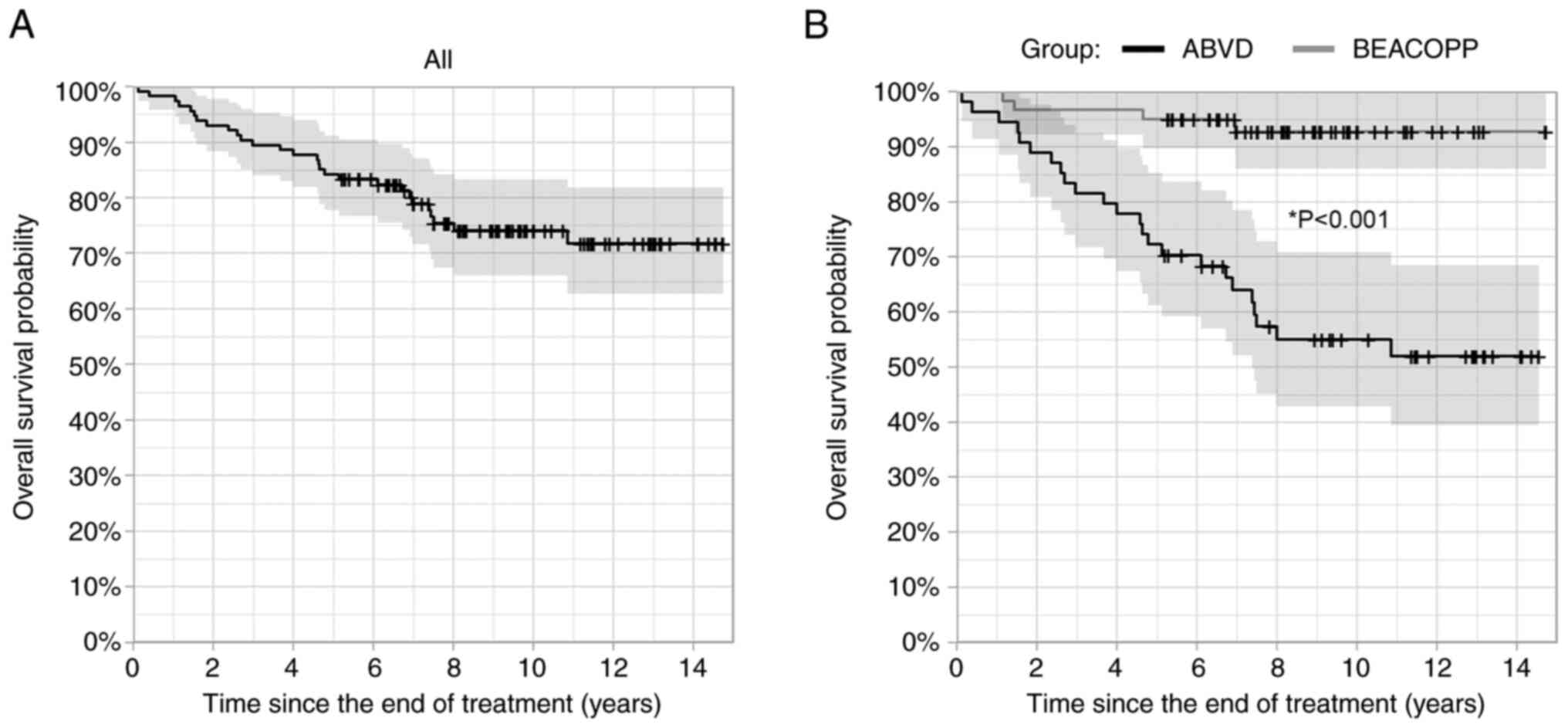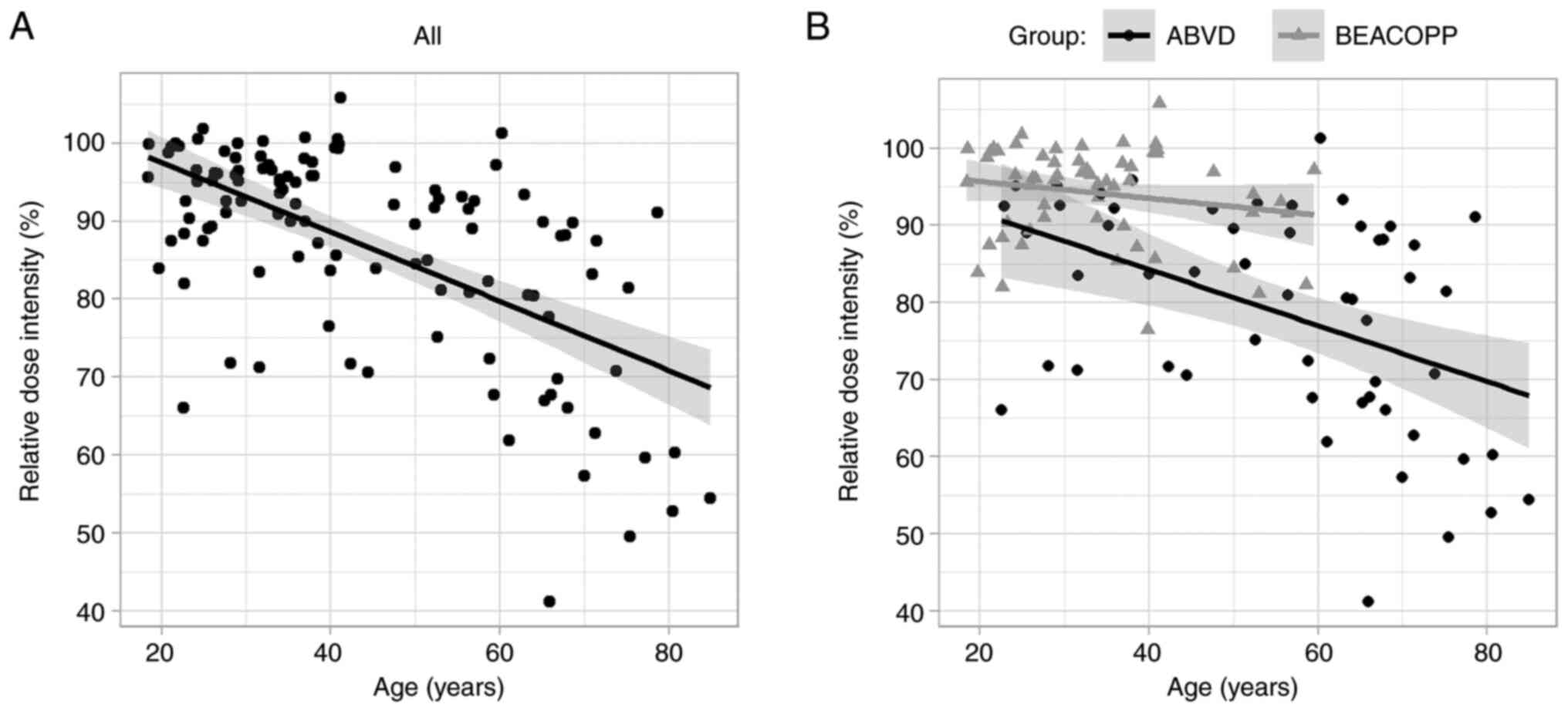|
1
|
Shanbhag S and Ambinder RF: Hodgkin
lymphoma: A review and update on recent progress. CA Cancer J Clin.
68:116–132. 2018. View Article : Google Scholar : PubMed/NCBI
|
|
2
|
Howlader N, Noone AM, Krapcho M, Miller D,
Brest A, Yu M, Ruhl J, Tatalovich Z, Mariotto A, Lewis DR, et al:
SEER cancer statistics review, 1975–2017, https://seer.cancer.gov/csr/1975_2017/simplehttps://seer.cancer.gov/csr/1975_2017/,
based on November 2019 SEER data submission, posted to the SEER web
site. National Cancer Institute; Bethesda, MD: 2020
|
|
3
|
Evens AM, Antillón M, Aschebrook-Kilfoy B
and Chiu BC: Racial disparities in Hodgkin's lymphoma: A
comprehensive population-based analysis. Ann Oncol. 23:2128–2137.
2012. View Article : Google Scholar : PubMed/NCBI
|
|
4
|
Zadnik V, Primic Zakelj M, Lokar K, Jarm
K, Ivanus U and Zagar T: Cancer burden in Slovenia with the time
trends analysis. Radiol Oncol. 51:47–55. 2017. View Article : Google Scholar : PubMed/NCBI
|
|
5
|
Cheson BD, Fisher RI, Barrington SF,
Cavalli F, Schwartz LH, Zucca E, Lister TA; Alliance, Australasian
Leukaemia and Lymphoma Group and Eastern Cooperative Oncology
Group, ; et al: Recommendations for initial evaluation, staging,
and response assessment of Hodgkin and non-Hodgkin lymphoma: The
Lugano classification. J Clin Oncol. 32:3059–3068. 2014. View Article : Google Scholar : PubMed/NCBI
|
|
6
|
Eichenauer DA, Aleman BMP, André M,
Federico M, Hutchings M, Illidge T, Engert A and Ladeto M; ESMO
Guidelines Committee, : Hodgkin lymphoma: ESMO clinical practice
guidelines for diagnosis, treatment and follow-up. Ann Oncol. 29
(Suppl 4):iv19–iv29. 2018. View Article : Google Scholar
|
|
7
|
Engert A, Plütschow A, Eich HT, Lohri A,
Dörken B, Borchmann P, Berger B, Greil R, Willborn KC, Wilhelm M,
et al: Reduced treatment intensity in patients with early-stage
Hodgkin's lymphoma. N Engl J Med. 363:640–652. 2010. View Article : Google Scholar : PubMed/NCBI
|
|
8
|
Specht L, Yahalom J, Illidge T, Berthelsen
AK, Constine LS, Eich HT, Girinsky T, Hoppe RT, Mauch P, Mikhaeel
NG, et al: Modern radiation therapy for Hodgkin lymphoma: Field and
dose guidelines from the international lymphoma radiation oncology
group (ILROG). Int J Radiat Oncol Biol Phys. 89:854–862. 2014.
View Article : Google Scholar : PubMed/NCBI
|
|
9
|
Fermé C, Eghbali H, Meerwaldt JH, Rieux C,
Bosq J, Berger F, Girinsky T, Brice P, van't Veer MB, Walewski JA,
et al: Chemotherapy plus involved-field radiation in early-stage
Hodgkin's disease. N Engl J Med. 357:1916–1927. 2007. View Article : Google Scholar : PubMed/NCBI
|
|
10
|
Canellos GP, Niedzwiecki D and Johnson JL:
Long-term follow-up of survival in Hodgkin's lymphoma. N Engl J
Med. 361:2390–2391. 2009. View Article : Google Scholar : PubMed/NCBI
|
|
11
|
Engert A, Haverkamp H, Kobe C, Markova J,
Renner C, Ho A, Zijlstra J, Král Z, Fuchs M, Hallek M, et al:
Reduced-intensity chemotherapy and PET-guided radiotherapy in
patients with advanced stage Hodgkin's lymphoma (HD15 trial): A
randomised, open-label, phase 3 non-inferiority trial. Lancet.
379:1791–1799. 2012. View Article : Google Scholar : PubMed/NCBI
|
|
12
|
Eich HT, Diehl V, Görgen H, Pabst T,
Markova J, Debus J, Ho A, Dörken B, Rank A, Grosu AL, et al:
Intensified chemotherapy and dose-reduced involved-field
radiotherapy in patients with early unfavorable Hodgkin's lymphoma:
Final analysis of the German Hodgkin study group HD11 trial. J Clin
Oncol. 28:4199–4206. 2010. View Article : Google Scholar : PubMed/NCBI
|
|
13
|
Canellos GP, Anderson JR, Propert KJ,
Nissen N, Cooper MR, Henderson ES, Green MR, Gottlieb A and
Peterson BA: Chemotherapy of advanced Hodgkin's disease with MOPP,
ABVD, or MOPP alternating with ABVD. N Engl J Med. 327:1478–1484.
1992. View Article : Google Scholar : PubMed/NCBI
|
|
14
|
Connors JM, Jurczak W, Straus DJ, Ansell
SM, Kim WS, Gallamini A, Younes A, Alekseev S, Illés A, Picardi M,
et al: Brentuximab vedotin with chemotherapy for stage III or IV
Hodgkin's lymphoma. N Engl J Med. 378:331–344. 2018. View Article : Google Scholar : PubMed/NCBI
|
|
15
|
Skoetz N, Will A, Monsef I, Brillant C,
Engert A and von Tresckow B: Comparison of first-line chemotherapy
including escalated BEACOPP versus chemotherapy including ABVD for
people with early unfavourable or advanced stage Hodgkin lymphoma.
Cochrane Database Syst Rev. 5:CD0079412017.PubMed/NCBI
|
|
16
|
Hryniuk WM and Goodyear M: The calculation
of received dose intensity. J Clin Oncol. 8:1935–1937. 1990.
View Article : Google Scholar : PubMed/NCBI
|
|
17
|
Wildiers H and Reiser M: Relative dose
intensity of chemotherapy and its impact on outcomes in patients
with early breast cancer or aggressive lymphoma. Crit Rev Oncol
Hematol. 77:221–240. 2011. View Article : Google Scholar : PubMed/NCBI
|
|
18
|
Charlson ME, Pompei P, Ales KL and
MacKenzie CR: A new method of classifying prognostic comorbidity in
longitudinal studies: Development and validation. J Chronic Dis.
40:373–383. 1987. View Article : Google Scholar : PubMed/NCBI
|
|
19
|
Kaplan EL and Meier P: Nonparametric
estimation from incomplete observations. J Am Stat Assoc.
53:457–481. 1958. View Article : Google Scholar
|
|
20
|
Cox DR: Regression models and life tables.
J R Stat Soc Ser B (Methodological). 34:187–220. 1972.
|
|
21
|
R Core Team R, . A language and
environment for statistical computing. R Foundation for Statistical
Computing. (Vienna, Austria). 2021.Available from. https://www.R-project.org/
|
|
22
|
Borchmann P, Goergen H, Kobe C, Lohri A,
Greil R, Eichenauer DA, Zijlstra JM, Markova J, Meissner J,
Feuring-Buske M, et al: PET-guided treatment in patients with
advanced-stage Hodgkin's lymphoma (HD18): Final results of an
open-label, international, randomised phase 3 trial by the German
Hodgkin study group. Lancet. 390:2790–2802. 2017. View Article : Google Scholar : PubMed/NCBI
|
|
23
|
Dann EJ, Bar-Shalom R, Tamir A, Haim N,
Ben-Shachar M, Avivi I, Zuckerman T, Kirschbaum M, Goor O, Libster
D, et al: Risk-adapted BEACOPP regimen can reduce the cumulative
dose of chemotherapy for standard and high-risk Hodgkin lymphoma
with no impairment of outcome. Blood. 109:905–909. 2007. View Article : Google Scholar : PubMed/NCBI
|
|
24
|
Gregory SA and Trümper L: Chemotherapy
dose intensity in non-Hodgkin's lymphoma: Is dose intensity an
emerging paradigm for better outcomes? Ann Oncol. 16:1413–1424.
2005. View Article : Google Scholar : PubMed/NCBI
|
|
25
|
Yamaguchi H, Hirakawa T and Inokuchi K:
Importance of relative dose intensity in chemotherapy for diffuse
large B-cell lymphoma. J Clin Exp Hematop. 51:1–5. 2011. View Article : Google Scholar : PubMed/NCBI
|
|
26
|
Gutiérrez A, Bento L, Bautista-Gili AM,
Garcia F, Martinez-Serra J, Sanchez B, Martorell C, Gines J, Garcia
L, Gimeno E, et al: Differential impact of relative dose-intensity
reductions in diffuse large B-cell lymphoma treated with R-CHOP21
or R-CHOP14. PLoS One. 10:e01239782015. View Article : Google Scholar : PubMed/NCBI
|
|
27
|
Owadally WS, Sydes MR, Radford JA, Hancock
BW, Cullen MH, Stenning SP and Johnson PW: Initial dose intensity
has limited impact on the outcome of ABVD chemotherapy for advanced
Hodgkin lymphoma (HL): Data from UKLG LY09 (ISRCTN97144519). Ann
Oncol. 21:568–573. 2010. View Article : Google Scholar : PubMed/NCBI
|
|
28
|
Raida L, Papajik T, Rusinakova Z,
Prochazka V, Faber E, Cahova D, Tucek P and Indrak K: Reduced
relative dose intensity of primary chemotherapy does not influence
prognosis of patients with Hodgkin lymphoma. Biomed Pap Med Fac
Univ Palacky Olomouc Czech Repub. 158:428–432. 2014. View Article : Google Scholar : PubMed/NCBI
|
|
29
|
Landgren O, Algernon C, Axdorph U, Nilsson
B, Wedelin C, Porwit-MacDonald A, Grimfors G and Björkholm M:
Hodgkin's lymphoma in the elderly with special reference to type
and intensity of chemotherapy in relation to prognosis.
Haematologica. 88:438–444. 2003.PubMed/NCBI
|
















